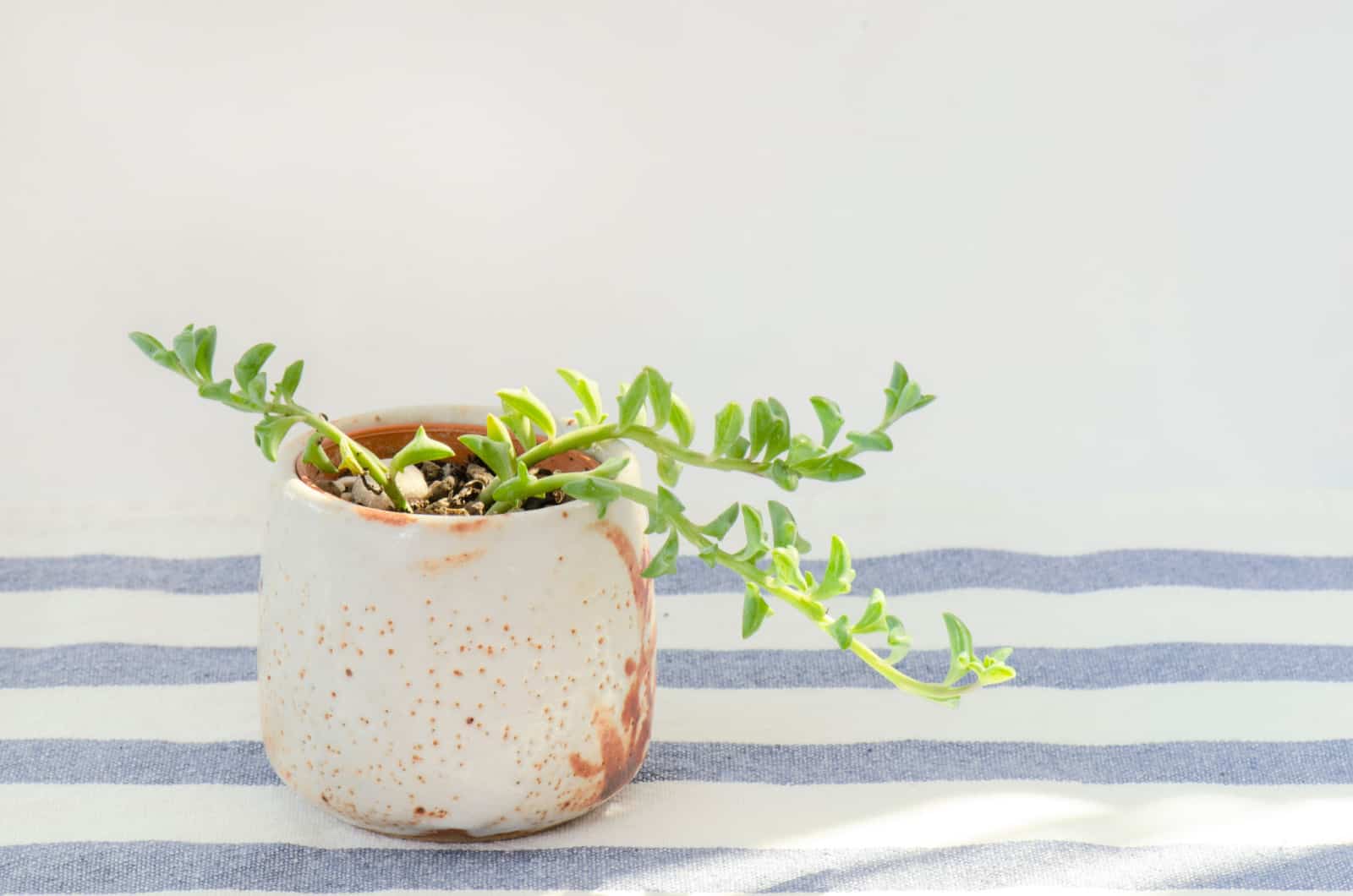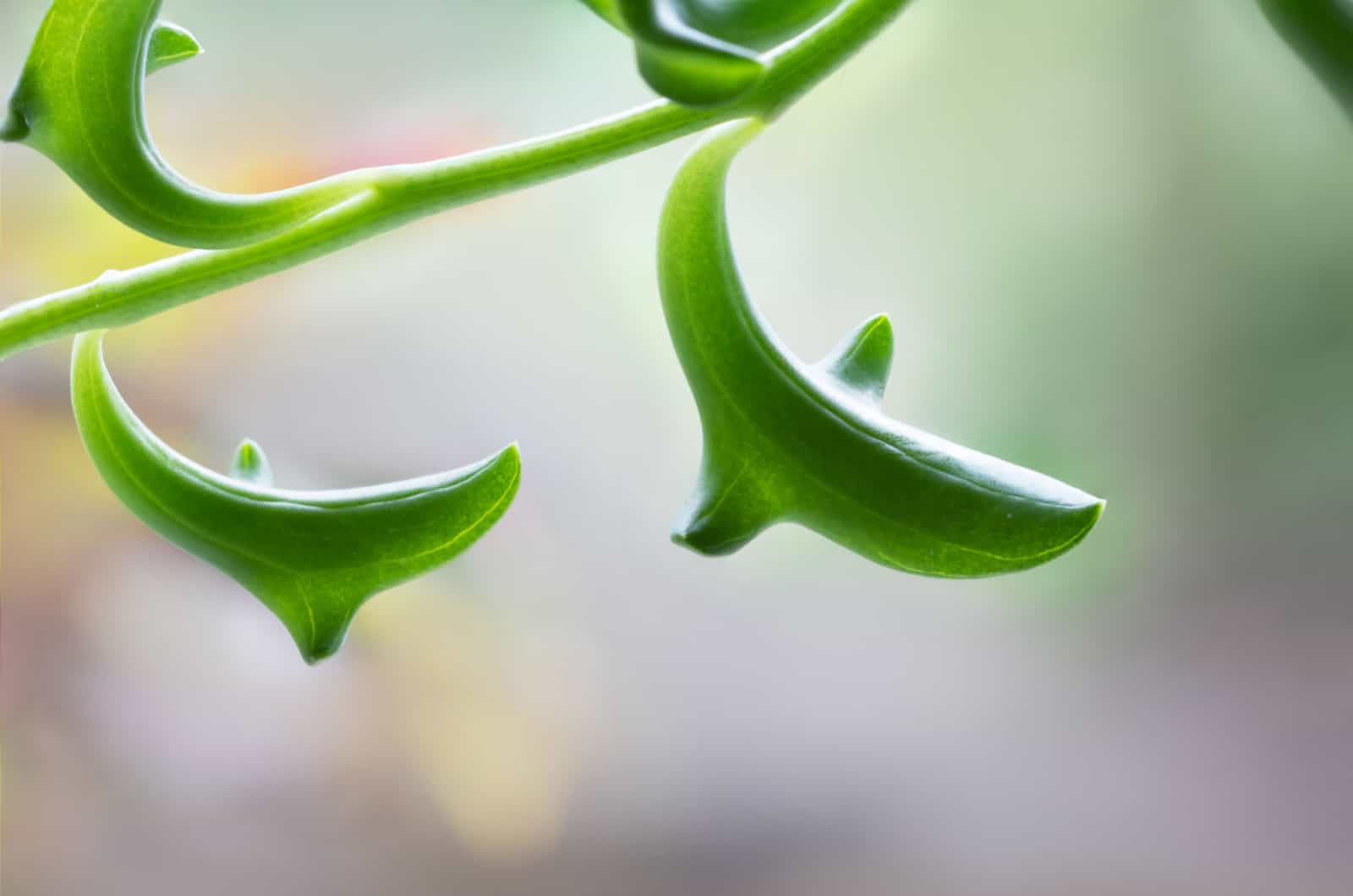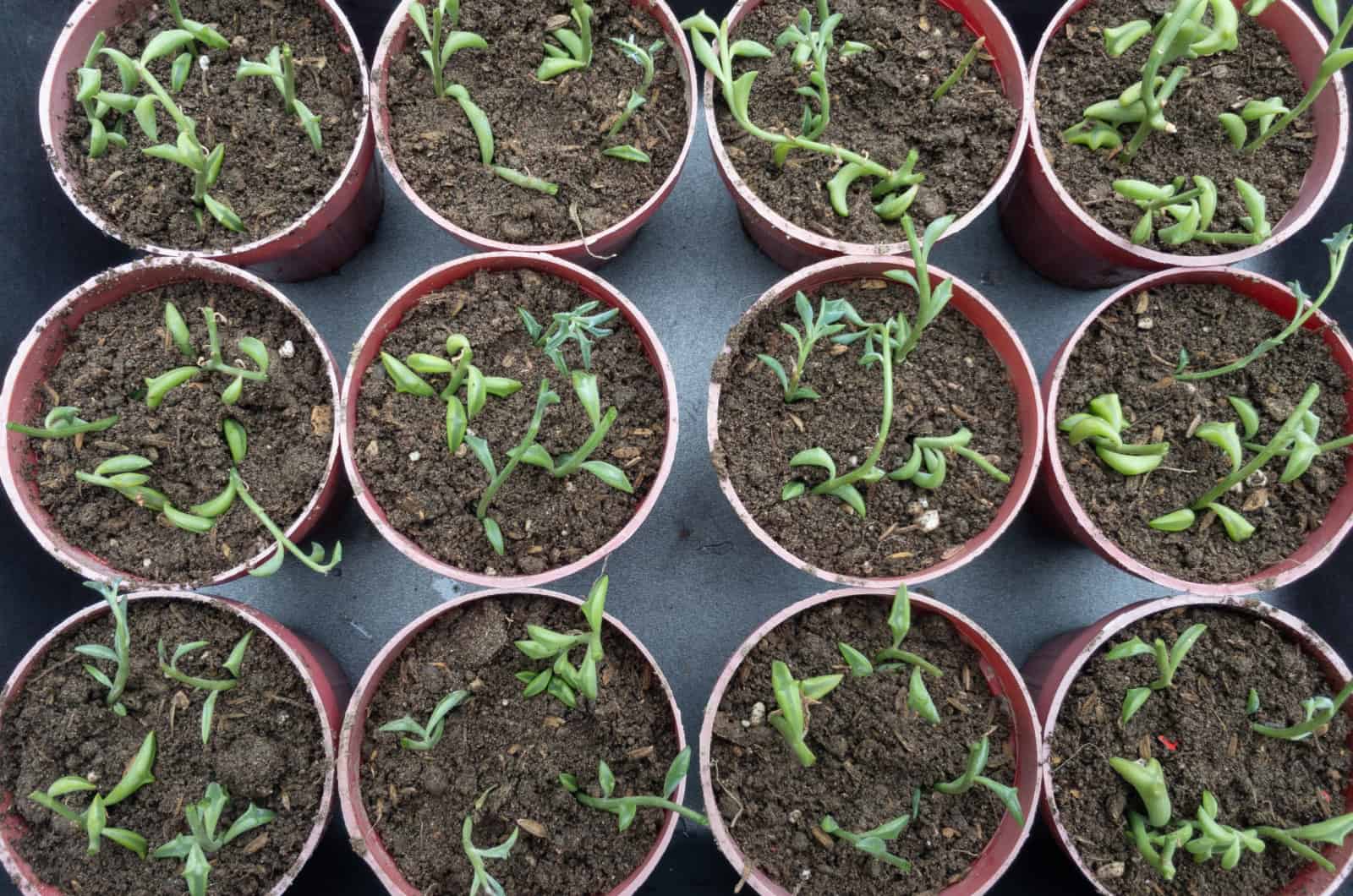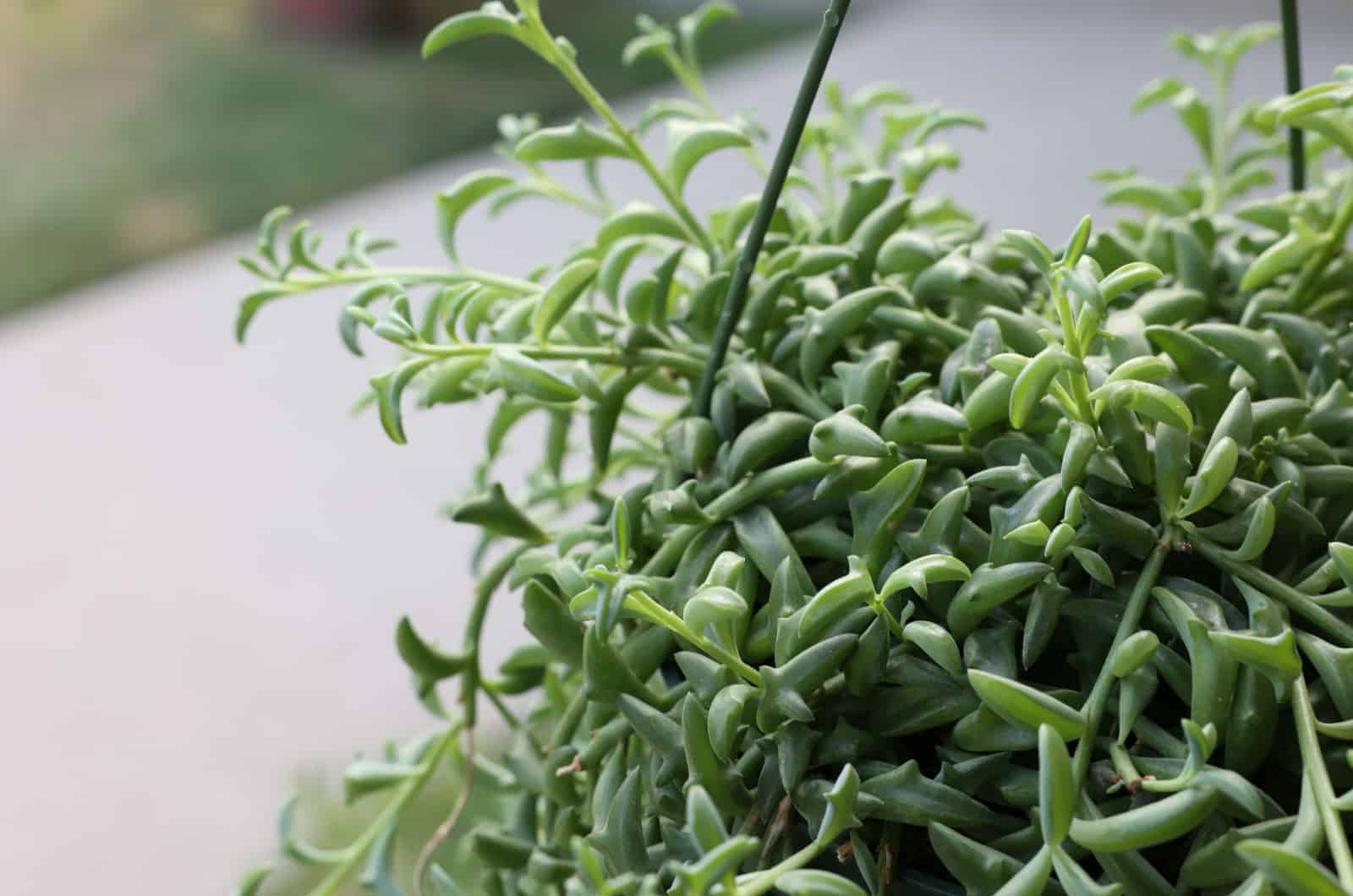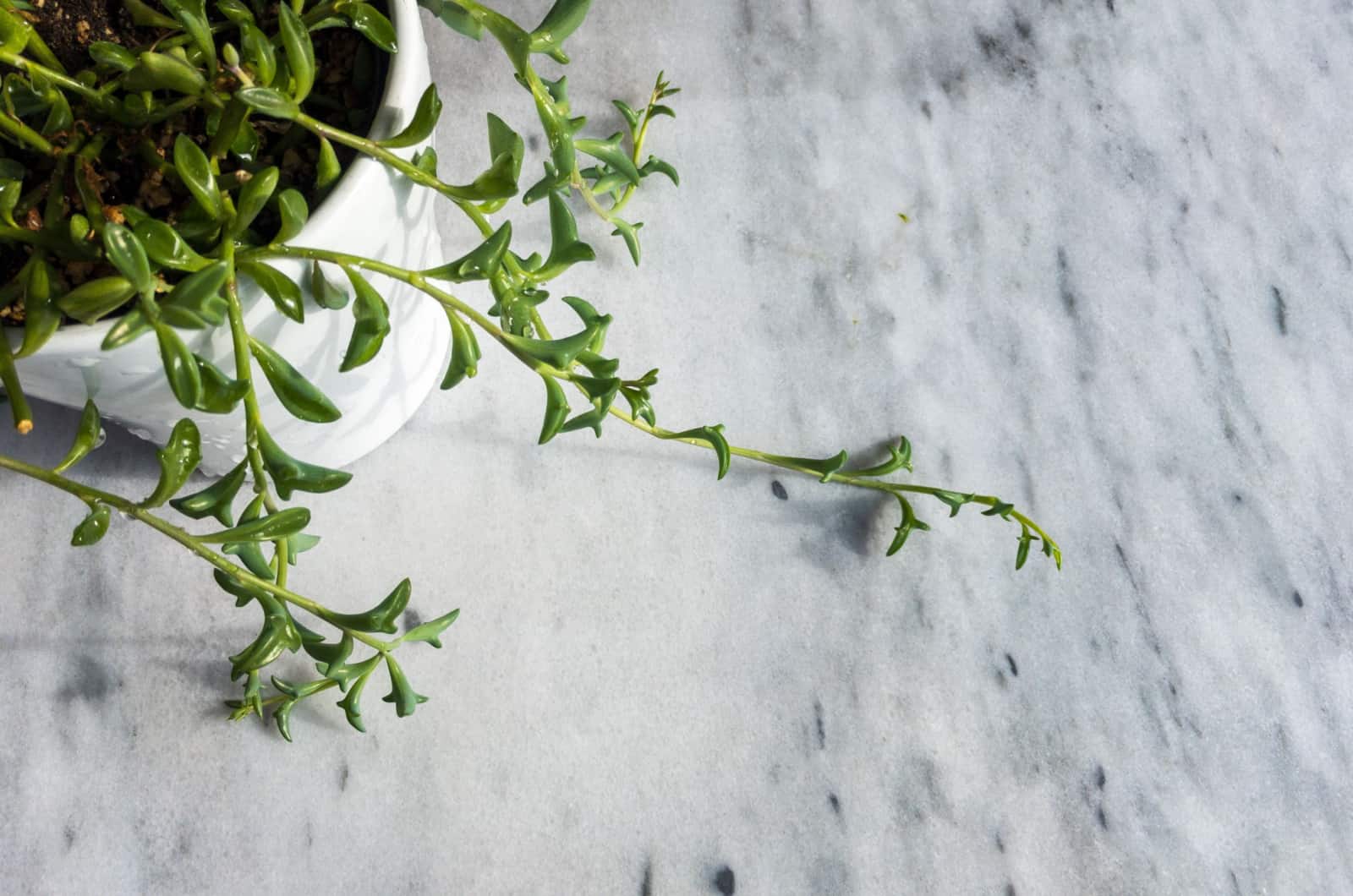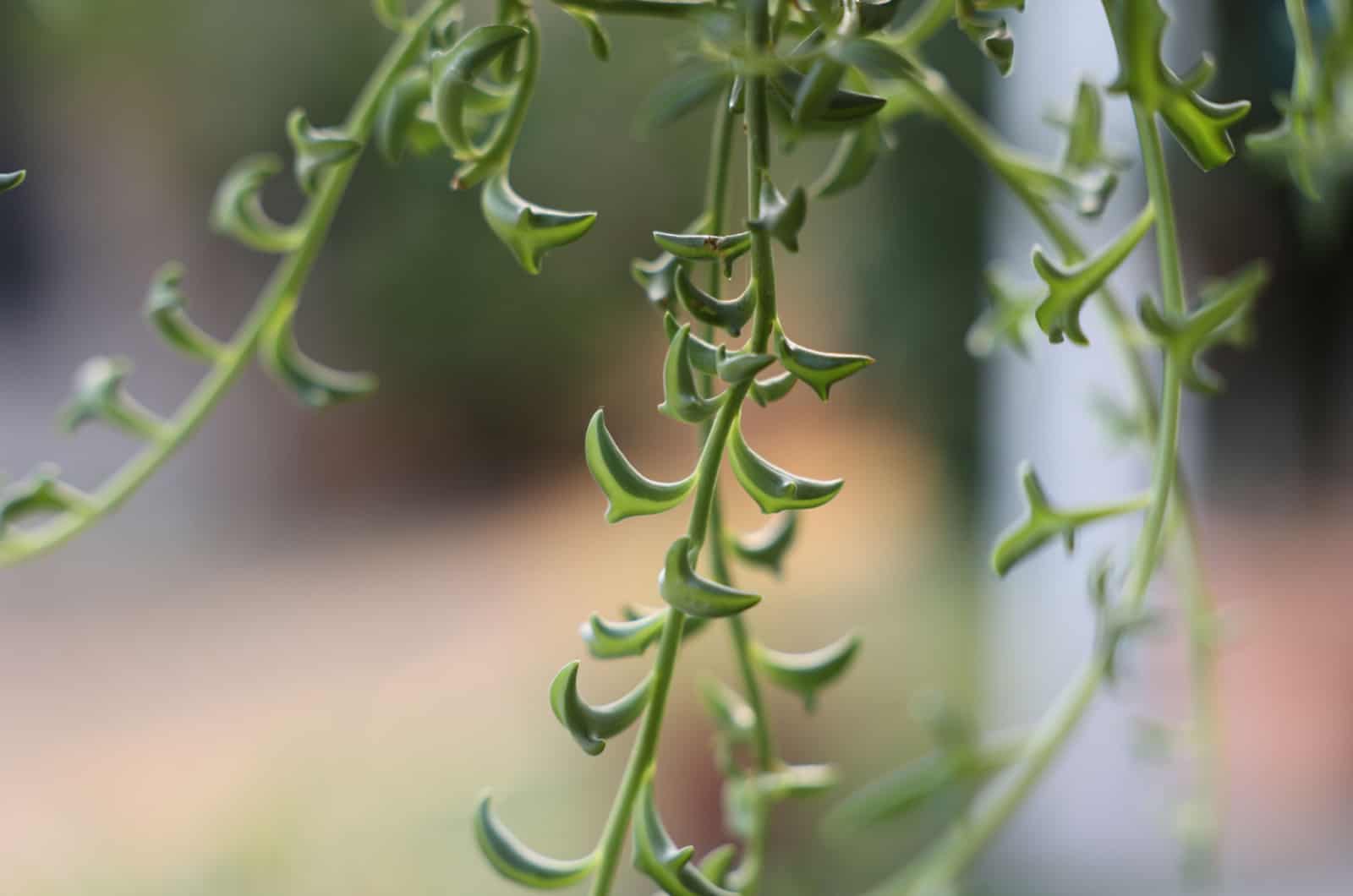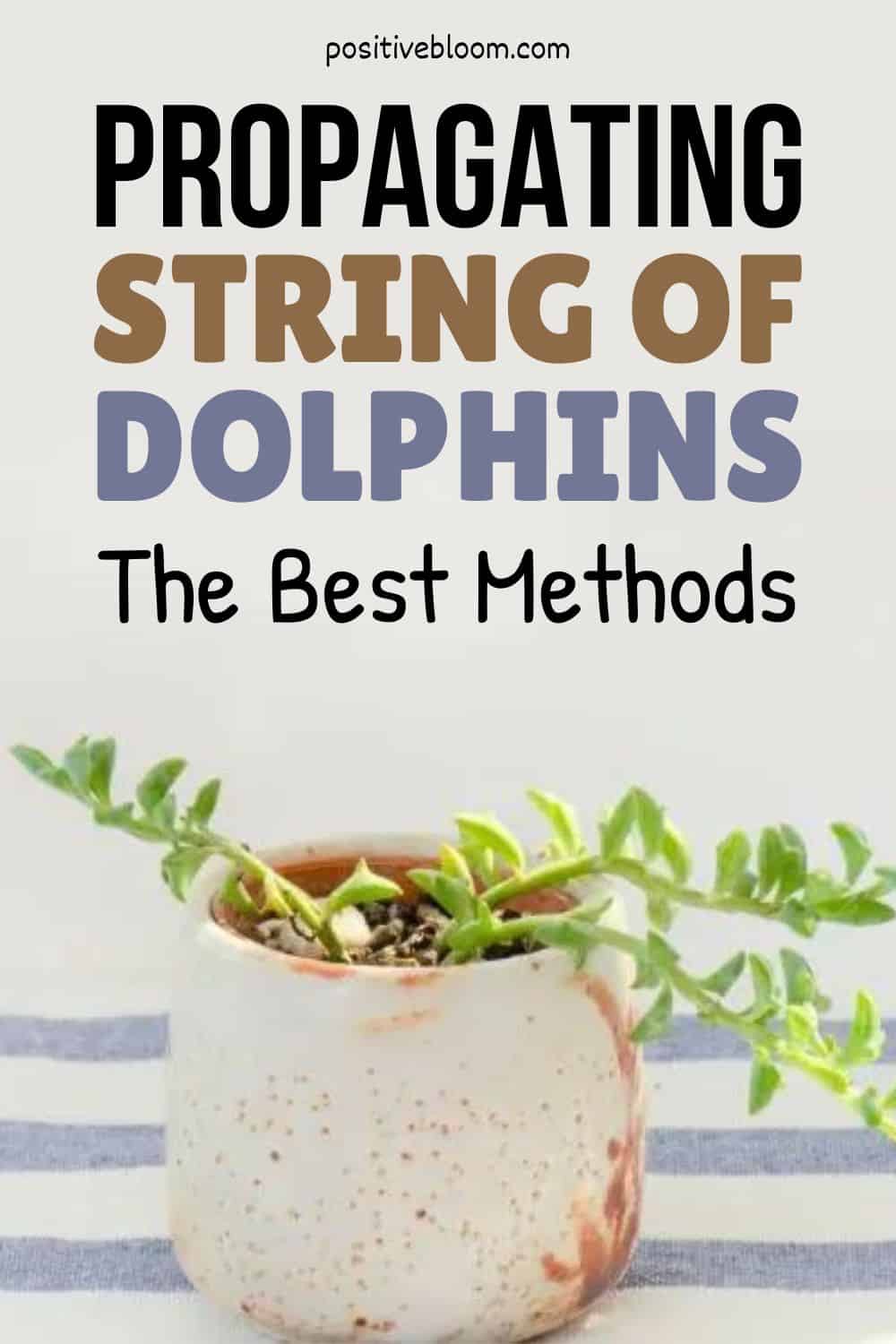Although the easiest way to get a new houseplant is by buying one from a plant store or online, there’s a cheaper and more exciting way of doing so, and it’s called propagation!
If you are new to the gardening world, there are a couple of things to take into consideration when choosing houseplants for your collection.
First, choose a plant that is easy to care for. Second, choose the one that looks the best to you (they all look great, but we have our personal preferences).
Finally, I also recommend plants that are easy to propagate. I would like to present to you a fantastic plant that’s easy to maintain, looks breathtaking, and can easily be propagated; the string of dolphins, a trailing succulent from the Asteraceae family!
You’ll be amazed by the plant’s stunning looks, and it’s even easy to maintain.
Today I’m going to show you some great methods for propagating string of dolphins.
All the methods are simple and interesting, and best of all, they have a high success rate!
Let’s get started!
Propagating String Of Dolphins: Stem Cuttings In Water
The first method I’ll show you is perhaps the most common. It’s also simple and perfect for beginners. The stem cutting method yields great results, and you can choose the medium for rooting the cuttings: soil or water.
We’ll first discuss how to root the cuttings in water, but prior to doing so you need to prepare some tools and learn how to take the cuttings.
Let’s learn more!
Tools Required
It is not wise to start propagating until all the necessary tools have been prepared.
The one thing you can’t start without is a healthy string of dolphins plant. Keep in mind that the root system should be completely healthy because any infection will destroy the propagation process, not to mention that it will damage the parent plant.
The stem is a vital part of the plant, and you’ll need a sharp knife for cutting to avoid damaging it. You run the risk of harming your precious string of dolphins if your cutting tool is blunt.
You must also sterilize the knife to avoid contamination. Rubbing alcohol or bleach are perfect for sterilizing solutions.
If you root the cuttings in water, you’ll need a deep, transparent dish for the cutting to develop roots.
You have various options, but many growers choose a jar or clear vase for this. When it comes to the perfect water type for plants, I recommend using filtered or rainwater.
A rooting hormone may also be handy if you’d like to speed things up. However, it’s not a must; the roots will develop healthily without it, but if you are impatient, feel free to use it.
Gloves are also optional, and I always use them when handling plants.
Once the string of dolphins cutting develops roots, it’ll need soil for further development. Read on to learn the perfect soil mix for this succulent.
Taking The Cuttings
Although the process of taking stem cuttings isn’t difficult, it’s essential to follow these steps carefully to avoid damaging the vines:
1. Choose a part of the string of dolphin vine that is about 4 inches long. There should be a few healthy leaves on the cutting. Alternatively, separate a lengthier segment of the mother plant and cut it into a few parts.
2. Make sure the nub is linked to any separate components you used for the cutting.
3. Find the part where the string of dolphins’ leaves connect, and make a cut above it.
Inspect the cutting again; if it’s healthy, it’s time to root it!
Submerging In Water
Remember to ensure you have the right water type and the medium you need for water propagation. You must now place the cutting in water, and we have detailed instructions on how to do so right here:
1. Add lukewarm, filtered water to the jar or vase. If using a vase, make sure it’s transparent so you can observe the roots during development.
2. Submerge a string of dolphins cutting in the water, but keep in mind that each stem must have at least one buried leaf node.
3. Be aware that the water can become contaminated if any part of the cutting is rotten, so I suggest refreshing it every few days. If you notice that the water in the jar smells terrible and is discolored, intervene immediately.
Brownish water means that part of the cutting has already begun to decay. Refill the container after removing the rotten parts. Please don’t remove the rotten parts with unsanitized tools.
4. When the new string of dolphins’ roots reach a length of about half an inch, pot them. The most important thing right now is not to leave new roots in water for an extended period as it will make it difficult to pot them or cause root rot.
How To Propagate String Of Dolphins Stem Cuttings In Soil
Now we know how to get a new string of dolphins plant by propagating the cuttings in water. However, you can skip the water part and root the cuttings straight in the soil if you prefer.
When using this method, examining the callus should be your primary concern. After you make a cut, soft tissue called a callus develops on the incision. This is essential as the new string of dolphins roots will form there, so wait about 2 days until you notice the callus formation.
Let’s learn how to root a cutting in soil!
1. Get a new potting soil. What you need right now is well-draining soil, and you can purchase a ready made succulent or cactus mix for this.
A different option is to create your own soil by combining regular potting soil, perlite or pumice, and sand used for gardening. The perfect ratio of these materials is 2:1:1.
2. Get the pot ready. Add soil to the pot and water it sparingly because damp soil will lead to root rot. The potting soil should fill two-thirds of the container.
3. Use a wooden stick or your finger to make a tiny hole in the soil. Remember that the hole shouldn’t be too deep or wide as the cutting doesn’t need much space.
If rooting multiple cuttings, make sure there is enough space between each of them.
4. Apply rooting hormone to the nodes. I always use a brush when applying rooting hormone.
5. Gently put the nodes in the holes and add soil mix to keep the string of dolphins cutting firm.
6. To maintain humidity, cover the pot with a plastic bag. Check for excessive moisture every few days to prevent mildew.
7. Put the pot in a spot with bright indirect light. Remember that the cutting needs more light in order to develop roots, but you must also make sure direct sunlight can’t reach it or it may get sunburned.
8. The pot should be placed as close to a sunny window as possible so that the plant can get filtered light.
The String Of Dolphins Plant: Propagation By Leaf Cuttings
Another excellent method for getting a new string of dolphins is through leaf cuttings.
The first thing to do is remove a healthy leaf from the bottom part of your string of dolphins. Remember, a clean and sharp knife is your best friend!
After removing the leaf, you should place it in a spot where it can’t be affected by excessive light, temperature, or humidity. You must also keep the leaf cutting away from direct sunlight.
The cutting needs enough moisture and heat, and only then will it develop healthy roots. It can take approximately a month for new roots to develop.
Don’t plant it as soon as you notice the roots form as it may actually take months until the cutting develops strong enough roots.
Waiting until the string of dolphins has robust roots before transplanting is crucial. The weak roots will be irreversibly destroyed if you rush things.
Check out our guide for propagating string of hearts, a cousin of the string of pearls.
When To Propagate String Of Dolphins AKA Senecio Peregrinus
You can technically propagate these succulents at any time of year, but taking the stem/leaf cutting during certain periods is better than others.
The growing season for a string of dolphins begins at the beginning of spring and lasts approximately until early fall. Your plant won’t display new growth during the winter months.
Therefore, I recommend starting propagation when the growing season starts. It’s way easier to get a new plant if you start in this period.
We also repot string of dolphins plants in the early spring, so you can take the cuttings and repot your succulent plant at the same time.
The Benefits Of Propagation
The dolphin-shaped leaves of this fascinating plant have made it a plant desired by many growers all over the world. It’s also a hardy plant, so it’s perfect for forgetful growers.
Let’s take a look at all the reasons you should propagate this wonderful plant.
Cost-effective
I once told my friend about the price of plants, and he couldn’t believe that a single plant can cost hundreds of dollars!
To avoid spending so much money on plants, you can propagate them instead.
We’ve discussed the tools you need for propagation, so you know that they are affordable.
Even if some tools cost more than others, remember that you can use them for many years to come.
Additionally, this plant may be challenging to find even though it has become popular and is easy to propagate.
Invest in a pretty hanging basket, and watch this trailing succulent put on a show!
Saves The Plant
Just like any other plant we grow in our houses, the string of dolphins may face different issues, and some may even have fatal consequences.
Remember, as long as there’s at least one healthy stem you can propagate successfully, you’ll be able to get a new string of dolphins.
Of course, the best thing would be to prevent these issues from occurring in the first place, so keep reading to learn about the perfect environment for this succulent.
A Perfect Gift
Are you looking for a perfect gift for your best friend?
You should consider propagating string of dolphins instead of spending money on expensive jewelry or fancy bouquets. The dolphin necklace has a fascinating appearance that’ll amaze anybody.
Even if your friend isn’t much into plants, I’m sure that once they see those stunning dolphin-shaped leaves, they’ll become plant lovers in no time.
How Long Does It Take To Propagate String Of Dolphin Succulent?
Succulents are known for their slow growth rate, and the string of dolphins isn’t an exception.
This plant is a hybrid of the string of pearls aka Senecio Rowleyanus, and the candle plant aka Senecio articulates, so it’ll take the same amount of time to get a string of dolphins as these two plants.
You’ll need to wait for about 2 weeks for new growth. However, this timeframe is when all requirements are met for a healthy plant.
Due to the slower growth rate, plant growers use different supplements to boost root development.
There’s one thing about succulents you must be careful with; over fertilization! You’ll be dealing with a leggy and pale string of dolphins that resembles a weed more than a trailing plant if you over fertilize.
Common Propagation Mistakes
If your string of dolphins succulent isn’t developing roots after a couple of weeks, something is wrong.
Here are a couple of possible reasons your plant isn’t rooting.
First, light level plays a major role in the healthy growth of the leaf/stem cutting. If your cutting doesn’t receive enough light, it won’t develop roots. Furthermore, the cutting is most likely to droop and, in some cases, turn yellow.
The same goes for too much sun. Direct sunlight will prevent the roots from sprouting and even cause sunburns on the cutting.
Light issues are related to both water and soil propagation.
The second issue is dry soil. When you transplant a stem cutting into the soil or root the stem/leaf cutting directly in it, warmer temperatures and high humidity may dry up the soil.
A string of dolphins needs saturated (not soggy) soil, and dry soil will prevent the new roots from sprouting.
On the other hand, low humidity and too much water in the soil will attract pathogens and cause roots rot.
If the stem cutting is submerged in water for too long, it may turn brown, soften, and eventually die.
String Of Dolphins Care Guide
I would now like to give you a couple of tips on string of dolphins plant care. The conditions below will work well for both propagated and established mature plants.
Let’s dive straight in!
Temperature
The first thing to mention is that the string of dolphins isn’t frost-tolerant. However, compared to other succulents, the string of dolphins can withstand lower temperatures better.
These plants can endure wintertime temperatures as long as they don’t drop below 40 degrees Fahrenheit.
When grown indoors, the Senecio articulatus grows well in average household temperatures, but never place it next to heating sources or vents. Temperature fluctuations and cold drafts will cause irreparable damage to your string of dolphins.
Humidity
When discussing humidity, the first thing to mention is that the average humidity level in our homes is around 30%.
Generally speaking, a string of dolphins performs well in moderate humidity. Still, anything lower than 40% may stunt its growth or cause other issues.
Many growers have wondered if succulent plants like humidity, and the general answer is no. Some species grow better in higher humidity levels, but not the string of dolphins.
If the humidity in your home is very low, try increasing it using terrariums, pebble trays, or humidifiers.
Light
Ensuring the correct light level is the trickiest part of the propagation process and general plant care for this trailing succulent.
The string of dolphins prefers bright light, but if it’s too bright it will damage it. So, you must provide it with indirect light. Placing your string of dolphins near a south-facing window is a great idea as it will definitely benefit from the morning sun.
If it receives too much light during the day, place a sheer curtain on the window to get indirect sunlight.
Problems may also arise if your string of dolphins is placed in low light. The best way to solve this issue is by using grow lights for plants.
Soil
Succulents perform best when grown in a well-draining potting mix.
Succulent soil is the best option for your string of dolphins. However, if you don’t want to buy a ready made soil blend, mix potting soil, perlite or pumice, and sand.
Watering
A succulent plant tends to retain water in its leaves, which makes them drought-tolerant.
This is an excellent feature as you can forget about the plant for a while, and it will still grow well.
However, there’s one disadvantage of this. Succulents don’t need much water, so it’s easy to overwater them.
Trust me, you don’t want to overwater your string of dolphins, as excess water in the soil will lead to a fungal infection and root rot.
Completely dry soil is the green light for watering. Be careful during dormancy because your string of dolphins will need even less water.
Fertilizing
The dolphin necklace plant doesn’t need to be fertilized on a regular basis. In fact, overfertilizing this plant may result in the loss of its unique, dolphin-shaped leaves.
Add fish emulsion or worm castings in the early spring to feed your string of dolphins.
There’s no need to use chemical fertilizers as an organic one will encourage flowering and promote growth.
Pruning
This trailing succulent should be pruned when any yellow or pale leaves appear.
There are two benefits of pruning a string of dolphins plant; encouraging growth and controlling the shape.
Sterilization is an important part of the pruning process. Don’t forget to sanitize your tools before you start trimming!
Repotting
The dolphin necklace plant does not require frequent repotting because it can endure being root-bound and grows pretty slowly.
Moreover, keeping the string of dolphins plant slightly root-bound is considered one of the best strategies to promote blossoms.
When repotting, pay attention to the new pot, particularly the size and material, and ensure it has drainage holes in the bottom.
A slightly larger terracotta pot will do wonders for this plant, and there are many available on Amazon.
Common Problems
The most common issues for a string of dolphins are related to indoor plant pests like mealybugs, spider mites, and aphids.
These pests can do severe damage to a healthy plant if not controlled. Early discovery and appropriate treatment are your best options.
Other issues are mainly related to watering. Overwatering will definitely do the most damage to your string of dolphins.
So, if the dolphin-shaped leaves start turning yellow and the soil is overly wet and mushy, check the root system because your plant could be suffering from root rot.
Another issue is underwatering; yes, a string of dolphins can be underwatered! If you notice paleness, wilting, and drooping, followed by overly dry soil, your string of dolphins needs a good soak!
FAQs
Is it better to propagate string of dolphins in water or soil?
Although both water and soil propagation are simple and have a high success rate, some may find one easier than another.
For example, if you are propagating string of dolphins for the first time, I recommend rooting the stem cuttings in water before transplanting them into the soil.
When using transparent rooting mediums, the root development will be visible so you’ll know what’s going on. If there are any problems, you can spot them on time.
On the other hand, if you propagate string of dolphins stem cuttings directly in the soil, you can’t see anything below the soil line, so if you are a beginner it may be pretty challenging to detect any issues on time.
How many strings of dolphins can you propagate at once?
There is actually no limit to the number of the string of dolphins cuttings you can propagate at once. However, there are two things to consider.
The first thing to pay attention to is the general condition of the cutting; as long as they’re healthy and have a node, you can take as many of them as you want.
Another thing is the size of the rooting medium; if you have more cuttings, make sure there’s enough space between each cutting.
Wrapping Up
If you grow string of pearls, string of hearts, string of bananas, or string of dolphins plants, I know that getting more of them will be high on your list of priorities!
There are two methods for propagating string of dolphins; stem and leaf cutting. If you are new to propagation, stem cutting water propagation is a great choice.
You can’t propagate string of dolphins leaf cuttings in water, but soil propagation will yield great results.
No matter which method you choose, I’m sure you’ll enjoy it! Once your new plant is established you’ll be able to enjoy a spectacular view!
Until next time!
Like this post? Share or pin it for later!

